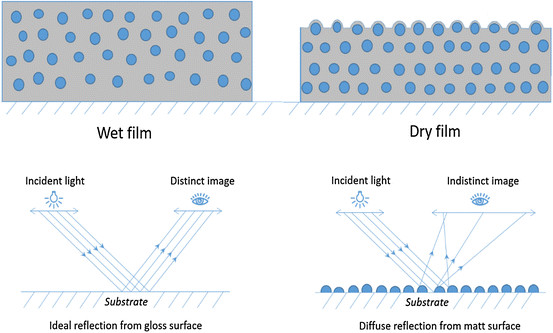Pumice flour has been used in the past to brush the dry paint film surface in one direction. The small scratches attained during this process created the fine, noble-looking matted surface. Nowadays, there is a wide range of objects produced with matted surfaces. Although some are complicated in construction, they are quickly manufactured. Additives based on silicas, waxes, organic materials and even fillers are added to the paint, to form a micro-rough surface after the drying process.

After applying a solvent-based paint: The solvent immediately starts to evaporate The viscosity increases, and The print hardens up until the final dry, hard and elastic paint film The evaporation of solvents causes the matting additives to be distributed throughout the whole film, making the paint film thinner. This shrinkage is the main reason for creating a micro rough surface, or, in other words, a matted paint film.
Achieving a matted paint surface can be done using a few different techniques. Here are some steps to help you achieve a matted paint surface:
1. Prepare the surface: Start by cleaning the surface you want to paint. Remove any dirt, grease, or old paint using a mild detergent and water. If there are any imperfections on the surface, sand them down to create a smooth and even base.
2. Choose the right paint: Look for a paint that is specifically formulated to create a matte finish. These paints usually have a low sheen and are available in various colors and finishes. Make sure to read the label to ensure it is suitable for the surface you are painting.
3. Apply a primer: Applying a primer before painting can help improve the adhesion of the paint and create a more even finish. Choose a primer that is compatible with the paint you are using and apply it according to the manufacturer's instructions. Allow the primer to dry completely before moving on to the next step.
4. Apply the paint: Use a brush, roller, or spray gun to apply the matte paint to the surface. Start by cutting in the edges with a brush and then use a roller or spray gun to cover larger areas. Apply the paint in thin, even coats, allowing each coat to dry completely before applying the next one. This will help prevent drips or uneven coverage.
5. Sand the surface (optional): If you want to achieve an even more matted finish, you can lightly sand the painted surface once it is completely dry. Use a fine-grit sandpaper and sand in a circular motion. Be careful not to sand too hard or you may remove too much paint.
6. Seal the paint (optional): If you want to protect the paint and enhance its durability, you can apply a clear matte sealer or topcoat. This will also help to further enhance the matte finish. Follow the manufacturer's instructions for application and drying times.
Remember to always work in a well-ventilated area and follow any safety precautions mentioned on the paint and primer labels. Additionally, it's a good idea to test the paint and technique on a small, inconspicuous area before applying it to the entire surface to ensure you achieve the desired result.
Anticorrosion Pigments, Inkjet Receptive Coating, Matting Agent